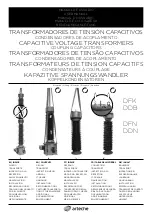
Page 2-6
V10/V7.5/V5/V3.5 Installation and Operation Manual
Issue 3.5
Section 2 Preparation for Use and Installation
2.2.4.1 Ac Wiring
For most applications, Nautel
recommends using 2 AWG ac wiring (for
1-phase V10s, Nautel recommends using
1 AWG). If smaller wiring is preferred,
refer to Table 2-2 to determine the
maximum phase current and suggested
wire size for your transmitter. Consider all
possible modes of operation.
NOTE
Observe local electrical codes when sizing
cables. The ac power source usually
presents the lowest impedance path to
ground potential for a lightning strike and
will normally carry most of the lightning
induced current away from the transmitter
site. When lightning hits the power source,
a significant amount of induced current
may flow towards the transmitter. Current
should be routed around the transmitter,
instead of through it, to the best ground
available.
2.2.5 Antenna Feed Cable
The shield of the antenna feed coaxial
cable should be connected directly to the
station reference ground where it enters
the building. In addition, the centre
conductor and the shield of the feed cable
should pass through a ferrite toroid that is
between the shield ground at the building
entrance and the shield termination at the
transmitter reference ground. This toroid
is transparent to the RF signal, but
presents impedance to transients
originating at the antenna. The transmitter
ancillary kit includes four 85.7 mm
diameter toroids (Nautel Part # LP23).
2.2.6 Antenna/RF Output
Disconnect
Incorporate a switching circuit into the RF
feed/antenna design, which disconnects
the antenna from the transmitter's RF
output when the transmitter is turned off.
This switching circuit will prevent lightning-
induced transients from damaging the
transmitter’s solid-state devices.
2.2.7 Antenna Tower
The antenna tower is the most likely target
for lightning strikes. It is imperative that it
contains lightning protection devices as
the first line of defense against lightning
strikes.
2.2.8 External Control/Monitor
Wiring
All external control/monitoring wiring that
may be subject to lightning induced
transients, should be interfaced to the
station reference ground by surge
protection devices at the point of building
entry. All conductors and their shields
should pass through a ferrite toroid that is
positioned between its surge protection
device and the transmitter. This toroid is
transparent to control/monitor signals, but
presents impedance to lightning induced
transients. There are three toroids
installed above the remote interface PWB
(see Figure 2-2). The transmitter ancillary
kit also includes four 38 mm diameter
toroids (Nautel Part # LXP38).
2.2.9 Electrical Power
The transmitter is factory configured to
operate from a 50/60 Hz, three-phase ac
power source between 180 and 264 V ac
or between 312 and 457 V ac or from a
50/60 Hz, single-phase ac power source
between 180 and 264 V ac. The ac power
source and associated switching
components and wiring must meet all of
the following requirements:
2.2.9.1 Voltage Stability
The ac power source’s nominal voltage
must be maintained within the specified
voltage range under all loading conditions.
The transmitter contains circuitry that
maintains the RF output at the pre-set
carrier level for voltage variations within
this range.
















































